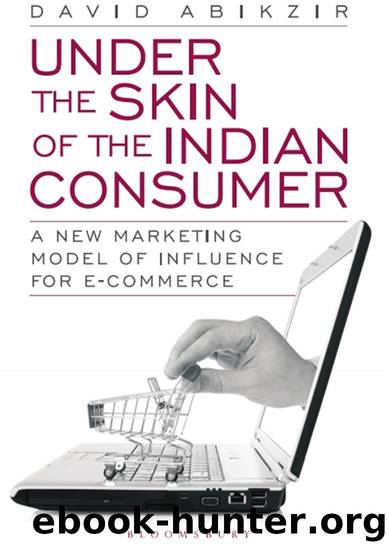Under the Skin of the Indian Consumer by David Abikzir

Author:David Abikzir
Language: eng
Format: epub
ISBN: 9789386643018
Publisher: Bloomsbury Publishing
Published: 2019-12-20T00:00:00+00:00
Figure 7.2 Plutchikâs Model of Emotions
The emotions intensify as they move from the outside towards the centre.
For instance, waiting for the traffic light to change is a cause for minor annoyance. But if we are held up for too long, our irritation soon turns into seething rage and we begin honking horns loudly!
All emotions are combinations of the eight primaries. These primary emotions can mix with one another to produce different emotions called âprimary dyadsâ:
âAnger + Anticipation = Aggressiveness
âAnticipation + Joy = Optimism
âJoy + Trust = Love
âTrust + Fear = Awe
âSurprise + Sadness = Disapproval
âSadness + Disgust = Remorse
âDisgust + Anger = Contempt
The âsecondary dyadsâ reflect the following emotions:
âJoy + Fear = Guilt
âTrust + Surprise = Curiosity
âFear + Sadness = Despair
âSadness + Anger = Envy
âDisgust + Anticipation = Cynism
âAnger + Joy = Pride
âAnticipation + Trust = Fatalism
Finally, the âtertiary dyadsâ reflect the following emotions:
âJoy + Surprise = Delight
âTrust + Sadness = Sentimentality
âFear + Disgust = Shame
âSurprise + Anger = Outrage
âSadness + Anticipation = Pessimism
âDisgust + Joy = Morbidness
âAnger + Trust = Dominance
âAnticipation + Fear = Anxiety
The real question for you is to know how Plutchikâs wheel of emotions can be applied in your e-commerce and especially in your communication strategy.
The goal is to emotionally connect the consumers.
First, âmake them happyâ. When you imagine a marketing visual, the expression on the faces of the persons represented is a key element. Make them smile to connect them to consumers. Inspire confidence that your brand or your product will transform their life for the better. Give them hope and they will be happy to use your e-commerce.
The highlighted emotions are joy, happiness, hope and trust.
The second element of your marketing visual is to âstartle them to attentionâ.
Use the element of surprise to catch the eye of the consumers. You can weave in the unexpected and the shocking to capture their attention. Once they are surprised, they will ask for more!
The goal is obviously to arouse curiosity. At its core, curiosity is all about noticing and being drawn to things we find interesting. When consumers are curious, they see things differently: they use their observation and exploration skills more fully.
The emotions highlighted are surprise and anticipation.
The third element is to âspin a storyâ.
Of course, spinning a story is an effective way to evoke emotions. The goal is to entertain them with tales that touch their hearts, make them laugh, or shed a tear. Stories motivate consumers to change their behaviour or thinking patterns more than hard facts ever can.
When you tell a story, you also prompt them to go into a reflective mode. They not only notice the details but also try to interpret these.
The emotions highlighted are amazement, delight, affection and pensiveness.
Finally, âevocative visualsâ is the last element.
You must use customised images that convey the right mood. Use evocative images and especially those that show people and faces. It is easier to feel connected to a person who looks and acts real than an impeccably-dressed model smiling at you from a stock photograph.
Visual metaphors can also have a significant impact on consumers.
Download
This site does not store any files on its server. We only index and link to content provided by other sites. Please contact the content providers to delete copyright contents if any and email us, we'll remove relevant links or contents immediately.
Art of The Strategic Side Hustle: Simple Steps to Developing a Passive Income Side Hustle (The Strategic Series) by Hodge Kimberly(100)
An MBA in a Book by Xander Cansell(96)
The Art of Building Your Resilience and Adaptability by Néstor Gandara(82)
Pragmarketism by Arvind Bhandari(80)
Whole Numbers and Half Truths: What Data Can and Cannot Tell Us About Modern India by Rukmini S(68)
The Sharesies Guide to Investing by Brooke Roberts & Leighton Roberts and Sonya Williams(63)
Under the Skin of the Indian Consumer by David Abikzir(62)
Corporate Chanakya on Leadership by Radhakrishnan Pillai(61)
Aesthetic Labour by Warhurst Chris;Nickson Dennis; & Dennis Nickson(58)
Playing for Time by Jeremy Lewis(57)
Breakpoints by Mike Ashby(56)
IEC 61636-2-2023 (IEEE Std 1636.2) by IEC(54)
Dream Believe Create by Hayley Lewis(51)
Crisis Investing for the Rest of the '90s by Douglas Casey(51)
Non-Profit Legends for Humanity and Good Citizenship by Moore Hank;(51)
Case of the Bonsai Manager by R Gopalakrishnan(50)
IEC 61136-1-1992 scan by Unknown(48)
Fine Printing and Private Presses by Roderick Cave(46)
SMARTS: Are We Hardwired for Success? by CHUCK MARTIN PEG DAWSON AND RICHARD GUARE(39)
